![]()
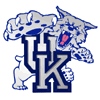 | - Part One - | 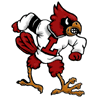 |
![]()
[Link to All-Time Series Results]
The series between Kentucky and Louisville is one of the fiercest rivalries in college basketball and, although it is between two schools within an hour drive of one another, remains one of the most high profile and anticipated rivalries in the nation. The two schools have often exemplified a contrast in styles (blue & white versus red & black, urban versus rural, white versus black, fast-break vs. more traditional offensive sets etc.), but sometimes the rivalry is surprising in its many contradictions. For example, Kentucky projects itself as the most successful program in college basketball, yet it was the University of Louisville which was arguably the most successful program in the 1980's. Louisville often projects itself as a program with a fast-paced modern and entertaining style of play, yet it was Kentucky which not only used a fast-paced style of play to dominate the 1990s, but which played an important role in the development of the fast-break decades earlier. Kentucky often projects itself as the long-standing keepers of tradition in contrast to Louisville which it terms as late-comers. Yet it was the University of Louisville which can trace its history back over 200 years, well before UK's early years began. The University of Louisville vehemently challenges the suggestion that they play the role of "Little Brother" to Kentucky (as suggested at one time by a Kentucky coach), yet interestingly U of L has in fact often benefitted from having a number of its players who were the younger brothers of former Kentucky netmen. The series rivalry itself is a contradiction since for a majority of the years since the two universities began putting teams in competition, the schools never scheduled each other during the regular season, with the longest drought being over 60 years without a regular season matchup.
With so much basketball success (including 9 NCAA titles) between the two programs, the differences in style, the competition to recruit and the relative proximity, there is bound to be bad blood between the two programs periodically. This has flared up at times through the years, from the early days when there were harsh accusations that UK was avoiding a match to crown the State Champion in 1916 to the present day when there were feelings of betrayal among Kentucky fans when their former coach Rick Pitino signed on to lead the Cardinals in 2001. Yet despite the memorable confrontations, personalities and strong emotions, most of the on-court battles have been fairly played and good natured. It is often outside of what occurs on the basketball court which defines this series. As Dave Kindred wrote about the fans of each school, "Louisville fans dismiss Kentucky zealots as insufferably arrogant dolts, and Kentucky fans consider Louisville zealots hopelessly deluded elitists. These people don't like each other -- for all the reasons that create tensions between neighboring major universities fighting for the same tax dollars, the same players, the same customers -- all inflamed by political wars colored by race, class and religion."
The national attention paid to what in reality should have been strictly a local rivalry is a testament to the outstanding coaches and players of both schools who achieved great things within all of college basketball and made the rivalry what it is today. The high level of success and accomplishment is a great source of pride within the entire Commonwealth.
![]()
Game by Game Review
The series between Kentucky and Louisville did not begin until 1913. Kentucky, still known as Kentucky State University at the time, had begun formal competition in 1903. This was over a year after a gymnasium which happened to be suitable for basketball was built on campus. The start of basketball on campus was only eight years after the very first intercollegiate game was ever held and 12 years after the sport itself was invented by Dr. James Naismith. The State squads struggled in the early years and often had to compete with other activities for use of the gym (including gymnastics and physical education classes which the structure was originally intended for). Their first squad was an ad hoc group of students who chipped in to buy the game ball and set about playing a game against a squad from Georgetown College in nearby Scott County. There was no coach and the squad ended the season with a less than stellar 1-2 record.
But the sport steadily gained in popularity on campus and by the teens, State University was establishing itself as a force to reckon with, at least within the boundaries of central Kentucky. Outside of those boundaries, when matching up against the likes of teams from the southern regions of Midwestern states along the Ohio River (and perhaps surprisingly against teams in Tennessee), State struggled. Southern basketball (of which most schools in Kentucky were lumped) was not highly thought of at the time. It would take literally decades to turn that maxim on its head.
Louisville Kentucky was a thriving city at the turn of the century. Situated beside a stretch of rapids of the Ohio River, the 'Falls City' was an important link for transport of goods from the eastern United States to the western part of the country, as goods traveling along the Ohio needed to be off-loaded at Louisville and transferred to the other side of the rapids. Much like Cincinnati upriver, the city of Louisville would seem to be an ideal place for the new sport of basketball to take hold (with a large number of people and ideas moving through at a constant pace) and it did to an extent as the very first organized games in the state were held at the Old YMCA on Fifth and Walnut Streets in Louisville starting in 1895. And like the Queen City, the popularity of basketball in the city of Louisville at the turn of the century was driven largely by an active YMCA and church leagues.
The University of Louisville, however, was a relative late-comer in terms of producing a formal basketball squad. The first year of competition wasn't until 1912 when William Gardiner agreed to coach a group of boys looking for something interesting to do. There was no gymnasium on campus, and the team had to instead use the floor of another local school (Tharp Business School). The first season resulted in an 0-3 mark for the Cardinal cagers, but it was a start of bigger and better things.
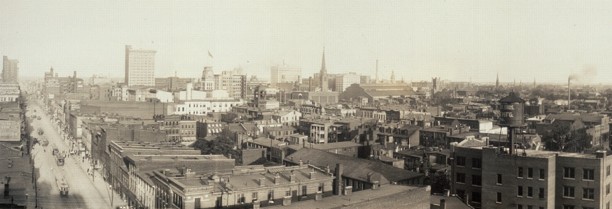
The following year saw State University and U of L basketball squads match up for the first time in history. Although the Cardinals reportedly still had no coach (one newspaper article suggests that Von Walther was the head coach), they did manage to win their first game ever on February 7 against the New Albany YMCA after losing their season opener. Clarence Rodgers, himself from New Albany IN, was the budding star for the Cardinals.
Kentucky wasn't in much better shape. Before the season started, the athletic director and the previous year's head basketball coach Edwin R. Sweetland resigned abruptly due to an embarrassing incident where a fire was set on campus by a pair of former students which partly implicated the athletic department. With Sweetland leaving, chair of the philosophy department Dr. J.J. Tigert was named as athletic director and also as basketball coach. Unfortunately, the job of putting together a schedule for the upcoming season was largely left unfinished and Tigert had to scramble to make a competitive schedule. Kentucky lost their first game in a heart-breaking decision to the Lexington YMCA, but came back to win the next two matches prior to their game against U of L.
On February 15 the Cardinals travelled to Lexington for the game against a UK squad which was now firmly under the guidance of Tigert. The game was held in the Buell Armory which was a part of Alumni Hall (later renamed Barker Hall). The game was part of a double header with the other game being a match between the UK girls team and the girls from Kentucky Wesleyan. $87.95 was collected in cash and coupons to more than offset the $76.00 in expenses and the match was considered a success.
On the court, Louisville was without the services of starters Stanley Walker (broken wrist) and John Daniel (sprained ankle). Clarence Rodgers scored all of U of L's points, on one field goal very late in the game and the rest foul throws. But it was Kentucky which ran away with the game early, speeding out to an 18-4 halftime lead. Three reserves were used in the second half but State still managed to add another 16 points to the winning 34-10 ledger. Center Roscoe Conkling (aka R.C.) Preston led UK with 6 field goals and a foul throw. Brinkley Barnett contributed nine points on three field goals and three fouls.
[Boxscore] - 1913
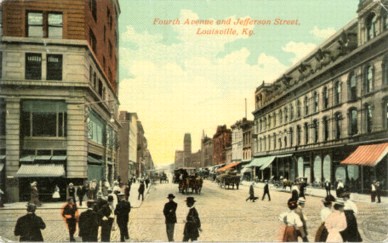
During the 1913-14 season, U of L was 2-6 with their only wins coming at home against Franklin (Ind.) and Rose Poly. They lost both of their games to KSC that year. Clarence Rodgers again was the leading scorer for the Cardinals. Kentucky was 5-2, with their only losses coming against Virginia teams while on a rare trip to the eastern side of the Alleghenies. Their leading scorer was senior R.C. Preston, although they were without their second leading scorer, Tom Zerfoss, who left the team after six games with a knee injury and eventually ended up transferring to Vanderbilt.
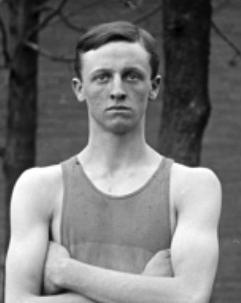 |
The second game was held in Louisville at the Tharp Business School Gymnasium located on Fifth and Zane. Through much of their early history, Louisville did not have their own gymnasium and had to make due by securing facilities around the city. The hulking Jefferson County Armory, situated on the State Fair Grounds, was built in the early part of the century and would certainly have been able to accomodate the games, however basketball as a sport wasn't developed enough at the time to require such a large arena. It wouldn't be until much later in the late 1930's (when Kentucky hosted a game against Notre Dame) that the facility would be outfitted with a playing surface suitable for basketball and the facility would first be used for this purpose. It was proven with the attendance at this later game and similar ones thereafter that the Armory's use for basketball was financially feasible.
In the game in 1914, Karl Zerfoss of Ashland (and brother of Tom) took the center position in place of James Park who was injured. (R.C. Preston had earlier in the season been declared ineligible for 'alleged professionalism') Zerfoss, who came on strong in the latter part of the season despite having to play multiple positions, scored 17 points to outscore the U of L squad all by himself. Rodgers scored over half of U of L's points.
This game holds a particular distinction in UK history as the result was somehow lost and was not recorded in the official record. Although the game was included in Louisville's all-time record, the game was only added to Kentucky's all-time results at some point much later. However when Kentucky added the result, the win was not included in the all-time victory total. Only in the late 1980's, after it was brought to the attention of a radio disc jockey, did UK move to amend its official record. This had to be approved by the NCAA and caused a large amount of publicity since at the time, Kentucky was trailing North Carolina by a single victory in the all-time wins category. The adjustment put the two teams back into a tie for first place. Later North Carolina found some additional wins of their own, which at the time pushed UNC further in the lead. Since that time, Kentucky has reclaimed first place in all-time victories through their recent efforts on the court.
[Boxscore] - 1914
[Boxscore] - 1914
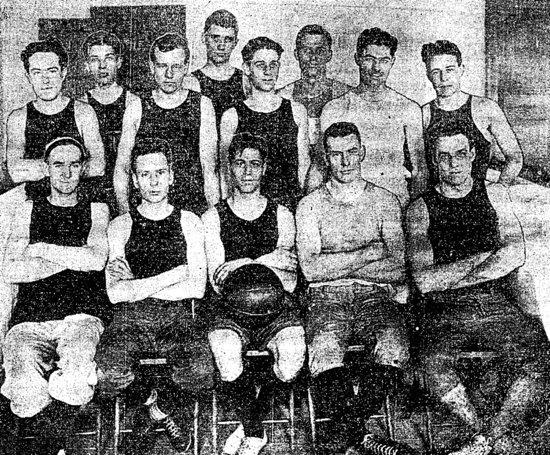 |
Standing (l to r): Eschrich, Kornfeld, R. Daniels, Strickler, Banter, Todd, Hall, McCaleb, Manager Sitting: Henry, Rodgers, Caldwell, Capt. J. Daniels, Walker |
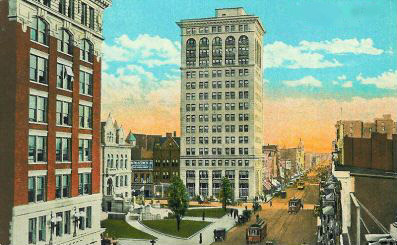
The following year the two teams split for the first time. The first game was played in Lexington before a large crowd at the Woodland Auditorium. The move to the Auditorium (also known as the Lexington City Auditorium) that year was prompted in part by the desire to accomodate a larger viewing audience. The event was a double-header, with the boys varsity starting off the festivities and UK girls, referred to as the 'Tabbies,' provided the nightcap. The Kentucky boys ran away with the game by a score of 27 to 16. Jim Server scored three field goals to lead UK from the field while Ralph Morgan added one field goal and scored on 6 free throws to lead the team in scoring. Clarence Rodgers scored 7 points, all on free throws, to lead Louisville.
The UK girls team also won, as Miss Olive Taul, Miss Florence Hughes and Miss Elsie Heller all scored at least three field goals to pace the Wildcats in a 27-16 decision. The victory gave them claim to the mythical State Championship among women's teams.
According to the Lexington Herald, the U of L boys team was coached by a person named, Moorman, yet the Louisville media guide claims the players coached that year. The chaperone of the girls squad was Miss Berry.
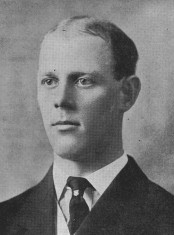 |
The return match in Louisville was the final game for Kentucky State University. The Wildcats had won every game they had played on their home floor (save one against Vanderbilt) and lost every game they played on the road (save one against Maryville). With a road game looming, they were hoping to break the pattern, however the match proved to even the series as the Cardinals won both the girls and boys games. This was the first ever victory for the U of L men's basketball team over Kentucky.
The girls game was held first and saw Miss Daisy McCallum score a field goal to lead U of L. The rest of the points in the game were all scored from the foul line. Miss McCallum, Miss Ann Koop and Miss Charlotte Wimp led the Cardinals and held UK's star, Miss Olive Taul in check with only one point to her credit.
Harding McCaleb led the Louisville boys by shooting 12 free throws. Clarence Rodgers added three field goals and Edwin Kornfeld and Maurice Daniels each added two field goals for the Cardinals. State University was led by Ralph Morgan, who scored two field goals and added 5 free throws for 9 points.
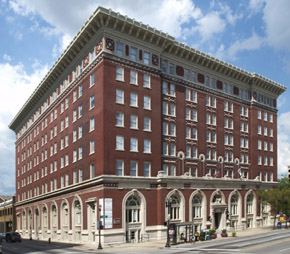 |
[Boxscore] - 1915
[Boxscore] - 1915
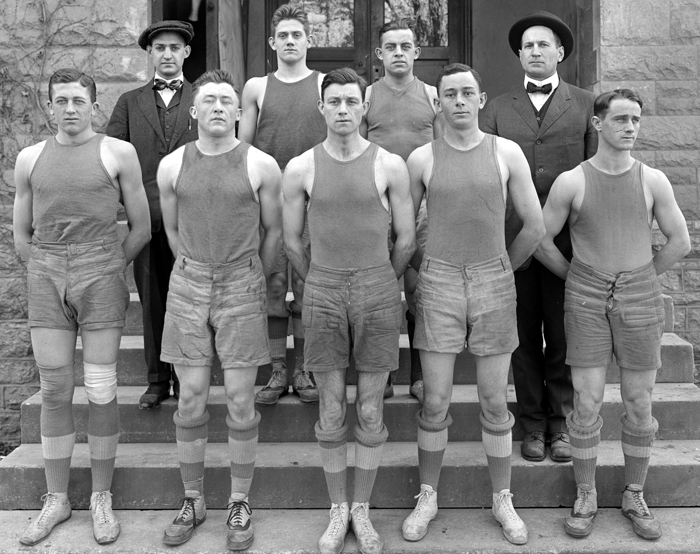 |
Back Row: Manager Abe Roth, Robert Ireland, Bart Peak and Head Coach Alpha Brumage |
Later that year Louisville joined the KIAC, but first had to broker a deal which got UK out of the organization in good standing before a ban against playing KSC would be removed. State University had been suspended by the organization in 1912 after withdrawing from KIAC competition in favor of the emerging SIAA (Southern Intercollegiate) organization. State University ended up paying back dues to the organization and this allowed U of L to continue to schedule Kentucky, a team against which they considered to be their chief revenue generator.
The first game of the match saw Louisville travel once again to Woodland Auditorium. Kentucky was led in name by Coach Tigert, however his assistants, former players James Park and William Tuttle, managed the day-to-day coaching activities.
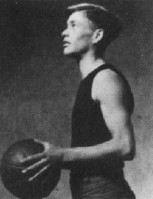 |
Said the Lexington Herald "State's team appeared to have been over-trained, over-confident or some one of the causes which usually contribute to the defeat of a superior team." Louisville got off to a large lead in the first half, 16-6, and was able to withstand a UK comeback. The Wildcats came back to tie the score 22-all, however at that point Edwin Kornfeld and William Rectenwald each scored a goal for the Cardinals to provide the final margin of victory.
The second game between the two that year was held in Louisville at the YMCA. This took some doing as Louisville had trouble securing a venue for the match in January and the game in question had to be rescheduled for February. After much back and forth between UK athletic director John J. Tigert and the Louisville administrator, Dr. Echart Von Walther, a location and date were finally established.
U of L had the opportunity to claim a stake to being called the Kentucky State Champion if they won the game. However the Cardinals came out flat and failed to utilize their signature passing game. The Wildcats played tough the entire half to gain a 20-10 halftime lead. The game was rough and many calls were made by the referee, Golde of Cincinnati, which appeared to the spectators and participants to be too strict and which handicapped both teams. This led to a total of 44 free throws being attempted in the game between the two teams, of which 26 connected. Despite the many whistles, no players fouled out although each team only used five players for the entire game.
Louisville fought back and cut the lead to four points in the second half, but UK extended the lead and won the game 32 to 24. Jim Server was the most dangerous Wildcat, as he connected on five field goals for his 10 points. Derrill Hart led the Wildcats with 20 points on three field goals and twelve foul shots. Harding McCaleb hit 14 free throws for his total, which led the Cardinals. (This was during a time when often a single player was chosen to shoot all the team's free throw attempts.) U of L's star, Edwin Kornfeld, was defended well by the Wildcats and limited to four points, which came on two long shots.
[Boxscore] - 1916
[Boxscore] - 1916

With the victory, both UK and Louisville shared a claim in the State Championship. Louisville had beaten Transylvania twice, Centre twice and Georgetown twice. Their lone defeat to a state school was against UK, against whom they split. Kentucky had beaten Georgetown and Centre twice with no other defeats to schools inside the Commonwealth. When asked to compile an All-State team, UK Athletic Director Tigert chose Kornfeld and McCaleb of U of L to his first team to go along with Hart, Server and Karl Zerfoss from State.
After the game, Dr. Tigert expressed his willingness hold a third game to face off with the Cardinals "on any floor that might be selected for the state title." However after not hearing back from U of L regarding a third match, Tigert decided to disband the squad after their final game against visiting Marietta (OH) in early March to prepare for other sports such as baseball. U of L's Von Walther claimed that it should have been up to UK to issue the challenge.
"A challenge for the championship of the state should come from State University and not from us, especially since State's coach, Professor Tigert ....had openly admitted to me that in his opinion we had the better team. .... We also knew that the coach of Centre College had ... tried to arrange for the playing of the championship game at Danville; our team would be perfectly willing to accept any challenge issued during this week, but not later."
As it turned out, a third match was never held and this misunderstanding only served to fuel the budding rivalry between the two schools. But the rivalry would be put on hold, as financial considerations caused U of L to not have a team for the 1916-17 season and the United State's involvement in World War I stressed every school's ability to hold extracurricular activities. By the time Louisville was back competing on the court, Kentucky was in the midst of a ferocious rivalry with Centre College to the south. Centre would be the first school from Kentucky to gain national attention at the time, mainly due to their prowess on the gridiron where they became known as the 'Praying Colonels.' Kentucky and Louisville would not meet again until the 1922 season.
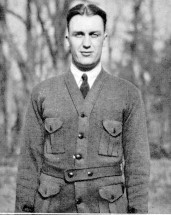 |
| UK Coach George Buchheit |
However all was not roses for the Wildcat team. Their very first game of the season, they were stunned by the Georgetown Tigers 26-17. Kentucky was without their star player, Hayden, who had injured his knee the previous spring, and had yet to return to basketball practice. Noted Hayden days before he died in 2003 about the knee, "At a track meet in the Spring of 1921, after the basketball season, I injured my right knee when I struck the take-off board for the Broad Jump. The knee was severely damaged. The next year I had re-entered UK taking education classes. I was eligible to play basketball but because of the knee I could not play regularly. When I was 94 the knee was finally replaced." Also ailing was guard Sam Ridgway, who was suffering from rheumatism. When the Kentucky team boarded the train at Union Station for their trip to Louisville, and later to Nashville where they would meet Vanderbilt, they left those two players behind to recuperate.
The game itself was held in the St. Xavier High School gymnasium, which had been built in 1916 on the site of the original school building and was considered at the time to be the best gymnasium in the city. Louisville began using the building for their own purposes in 1918, as did UK which squared off against Centre in a special match to decide the State Championship for 1918.
If Kentucky was hurting from the personnel losses, they didn't show it as they ran up a 23-2 halftime lead over the Cardinals. According to the Louisville Courier Journal "State presented a fast passing game coupled with accurate shooting and wonderful defensive work which had the locals on the run throughout." Paul Adkins led the Wildcats with 16 points. The Cardinals were led by Arthur Yeager who contributed six points.
[Boxscore] - 1922
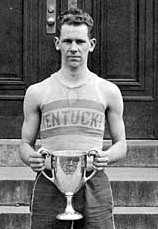 |
| UK's First All-American Basil Hayden |
Even with Hayden (who played most of the game) in the lineup, Kentucky faced a much more determined Louisville squad the second time around. This was evidenced by the halftime score which showed the Wildcats leading by only a single point, 11-10. In no small part due to the stellar defensive work of UK's back guard, "Dutch" Burnham, who stayed back and guarded the UK goal, Louisville was forced to shoot from the perimeter where they wowed the Lexington crowd with their long-range bombs. According to the Lexington Herald, "Louisville never made a field goal from a distance shorter than 15 yards. Most of the Cardinal's shots came from more than halfway down the court. Carter and Hocker made the crowds gasp with their uncanny skill at this game." The Cardinal's shooting kept the game close until about five minutes remained in the game. After that, Kentucky gained a comfortable lead.
But the star of the game was Hayden who, although scoring only two points, played a major role in the game both offensively and defensively along with being a source of inspiration for his teammates. According to the Kernel, "Hayden, though crippled, started the game, and his presence on the squad was like the addition of yeast to certain prohibited ingredients." Bill King was the scoring star for the Wildcats as he connected for 13 points. Horace Carter led the Cardinals with five long field goals and four free throws.
[Boxscore] - 1922
With that game, the regular season series between the two schools would go on hiatus for over 60 years. A large reason for the break was the arrival in 1930 of Adolph Rupp to the Lexington campus. Rupp was dedicated to bringing Kentucky basketball to a national level, something he was amazingly successful at as he made Kentucky a name synonymous with college basketball. However part of that effort was to break all ties with in-state schools. Rupp believed that in order to effectively build a strong program which could compete on a national level, it paid no dividends to become mired in rivalries against in-state competition. This philosophy frustrated to no end many rival fans and coaches, chief among them Western Kentucky's legendary coach Ed Diddle, Eastern Kentucky's Paul McBrayer and others, including Louisville's Peck Hickman and later Denny Crum.
The snub was especially stinging for Louisville as they could only watch as Rupp began to host a hugely successful series against Notre Dame in the nearby Jefferson County Armory along with seeing UK dominate many SEC Tournaments which were held at the facility. During the 1930's, the University of Kentucky also enjoyed great success in attracting many prep players from the city of Louisville, among others Warfield Donohue, Russell Ellington (who transferred to UK from the University of Louisville), James Goforth, Joseph Hagan and future All-American Lee Huber.
Despite the lack of games played, that's not to say there was no interaction between the two programs in the intervening years. World War II was likely the catalyst for a rash of former Kentucky players eventually transferring to the University of Louisville. During the war years, teams were comprised mainly of freshmen and sophomores along with the rare cases of athletes who were declared physically unfit for military service. Just as players got their feet wet on campus, they were often drafted into the military. This continuous turnover made it a constant struggle to keep a roster filled and created a revolving door of players entering and exiting the program at an alarming pace. Louisville had to cancel their season in 1942-43 for this reason and Kentucky nearly had to shut down its basketball program during the war years also.
When the war was over, most all of these former players were able to return to college to complete their education (thanks largely to the GI Bill), and in addition still had basketball eligibility available. Those post-war Kentucky teams had some of the greatest assemblages of talent, not just in Kentucky history but in NCAA history. Many of the former UK players were lost in the shuffle and found more appealing options elsewhere.
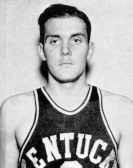 |
| Clyde "Ace" Parker |
'Ace' Parker's brother, Glen Parker, played briefly at Kentucky during the early part of the 1943-44 year before he too was called to serve in the armed forces. When he was discharged years later, he received a letter from Rupp informing him that his basketball services would not be required at UK. The second Parker brother then enrolled at Louisville, although he chose to concentrate on graduating and did not play basketball for the Cardinals.
Another UK player on that 1943-44 squad who eventually transferred to Louisville was 6-5 center Truett DeMoisey from Walton Kentucky. DeMoisey was the younger brother of John DeMoisey, who was an All-American at UK under Coach Rupp in the early 1930's. After the war, Truett found the Fabulous Five firmly established at UK and ended up playing elsewhere. First at Ohio State and later for Louisville during the 1948-49 season where he averaged 5.5 points per game while backing up U of L great Jack Coleman. The following year DeMoisey was injured and could not compete on the hardwood for his senior year.
Probably the most significant transfer from UK to Louisville during that time was Deward Compton of Nashville Tennessee. Compton arrived from Castle Heights Military Academy and played at UK during the 1944-45 and 1945-46 seasons where he backed up players such as Alex Groza, Wallace Jones and Kenton Campbell at the center position. Likely sensing a lack of playing time with Groza and another All-American center Bob Brannum returning from the war, Compton transferred to Louisville for the 1946-47 season where he averaged 6.6 points per game. The following year, Compton was named the U of L captain and upped his averaged to 10.5 points per game. He (along with Jack Coleman and others) helped guide the Cardinals to an improbable NAIB championship and he later would be the first Cardinal drafted by an NBA team (Philadelphia Warriors 1948) and even later would be named to the Cardinal Athletic Hall of Fame.
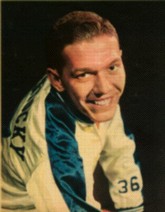 |
| UK All-American Ralph Beard |
Beard played football for UK in the fall of '45, but injured his shoulder after the fourth game of the season. When a UK coach suggested that 'nobody on this team has any guts,' Beard took the criticism personally. He left campus and returned home to Louisville.
"When I woke up the next morning I went down to U of L to see about enrolling there," Beard told the Courier-Journal in 1949. He met with Hickman that day and nearly transferred. But Beard's family and friends persuaded him to return to UK before attending any U of L classes. The next day, he went back to Lexington.
"We probably could have talked him into coming," said Hickman, "but he wasn't going to be happy here because he had too many other people telling him to go to UK and play for Adolph Rupp. I couldn't see trying to talk him out of doing something he really didn't want to do."
While Beard was deciding what to do, Rupp brought him in for a long talk. At the end of the conversation, Rupp reportedly told Beard these memorable words "Son, I can't keep you from going to UL, but I will tell you one thing: we here at the university will not cancel our schedule."
Beard ended up staying on at UK and becoming one of the greatest guards in college basketball at the time. He was the catalyst for the 1948 UK team, the original 'Fabulous Five' which included another All-American player in center Alex Groza. Kentucky blitzed the nation with their exciting brand of basketball en route to a 31-2 record. Kentucky went on to the NCAA Tournament where they swept the field and beat Baylor for Kentucky's very first NCAA title.
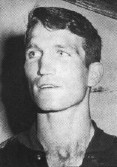 |
Under Coleman's leadership, the Cardinals won their first national title that year by taking home the NAIB tournament crown. Also on the 1948 Cardinal team besides Coleman was Deward Compton and Ken Reeves among others. But the Cardinals road to success was in many ways unexpected. Partway through the year, Louisville's national aspirations for the year looked to be dead in the water. After beginning the year 9-0, they hit a stretch of games where they were beaten by Xavier by 28 points (a team UK beat twice by an average of over 30 points), lost to Murray State and were beaten by Hickman's old coach, Ed Diddle and his Western Kentucky team by 27 points. Louisville struggled within their own KIAC conference, beating Kentucky Wesleyan by only four points, and losing to Western two more times. But the Cardinals were improving as evidenced by the fact that their final loss to Western in the KIAC tournament was by a single point. (Their previous loss was by 22.)
After the conference tournament, Louisville entered the NAIB small college tournament in Kansas City. Highly ranked Western Kentucky entered the NIT while top-ranked Kentucky entered the NCAA Tournament. Not much was expected of the Cardinals, but they continued to improve and dispatched five teams to take the crown. This included the same Xavier team which had blown them away earlier in the season along with a John Wooden-led Indiana State team in the finals.
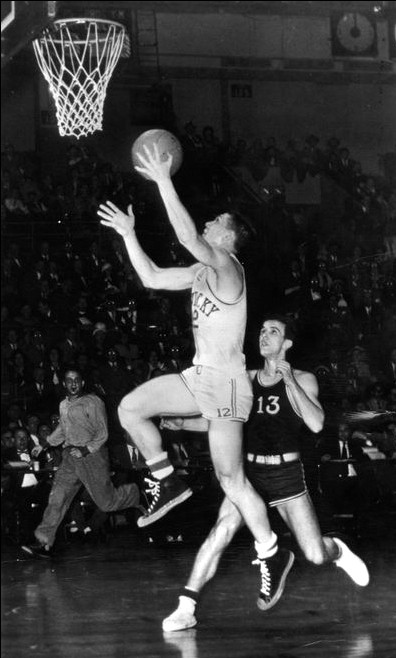 |
in front of Ken Reeves |
Kentucky and Louisville were matched up in the first round of the four-team collegiate bracket. The other side of the collegiate bracket saw NYU face off against the NCAA runner-up Baylor Bears. It is notable that the assistant coach for U of L that year was Dave Lawrence, the former player at Kentucky in the 1930's.
 |
Kentucky hit 37 field goals in the game, which at the time was a new record at the Garden and largely controlled the floor with their ball-handling on their defense. The 200 Louisville fans (which included the mayor of Louisville) went home dejected as the Wildcats won going away, 91-57. Kentucky would go on to win the collegiate portion of the tournament by beating Baylor for a second time within a week before bowing to the AAU champion, the Phillips Oilers, who were led by 7 footer giant Bob Kurland. The combined Kentucky-Oilers team would proceed to win the 1948 gold medal for the United States in London.
[Boxscore] - 1947-48 Olympic Trials
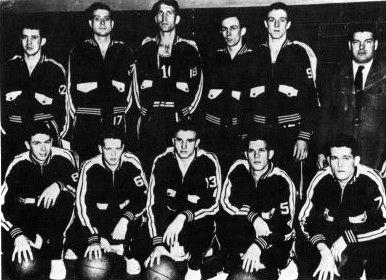 |
The following year, with a taste of direct competition with UK fresh and with star Jack Coleman in his senior season and former UK player Truett DeMoisey among others expected to contribute to a strong Cardinal squad, Louisville's president saw the opportunity to break UK's long-standing policy of not playing in-state schools. The school offered $10,000 to UK to accept a two-game series for the upcoming 1948-49 season. Kentucky refused the offer as they stuck to their policy of not competing against in-state schools. This stubborn stance by the Wildcats may have been effective during the regular season but with the dawning of the age of post-season tournaments, the NCAA had the will and the power to change the situation, and they would soon act on that desire.
In the 1950-51 season, Louisville received an at-large bid to the NCAA Tournament with a 19-6 record (despite losing four of their last six regular season games). The tournament field that year had been expanded from eight to sixteen, with ten of the spots reserved for conference champions of ten of the major conferences from around the nation. This was the first time the Cardinals had received an invitation to the NCAA Tournament. Their opponent in the first round would be the Wildcats, a feat which would otherwise have never happened without the intervention of the NCAA. Louisville was led by 6-5 forward Bob Lochmueller (father of future UK player Steve Lochmueller), who averaged 19 points per game on the season, and Bob Brown who added over 15 points per game.
Kentucky in the 1950-51 season looked to be on top of the world. The Wildcats were led by lanky 7-foot All-American center Bill Spivey, spark-plug Bobby Watson along with future Hall of Famers in sophomores Frank Ramsey and Cliff Hagan among others.
The Wildcats had compiled a #1 ranking during the regular season with their only setbacks coming in a quirky loss to St. Louis in the Sugar Bowl Tournament in New Orleans, and a loss in the SEC tournament championship game to the Vanderbilt Commodores. The SEC tournament that year was held in Louisville's Armory, as it had often in the past since 1941. While Kentucky refused to play the Cardinals, they were more than happy to use the Armory against other teams where they could benefit from the large gate receipts and strengthen their fan support in the region.
If the unranked Cardinals didn't find themselves at enough of a disadvantage, the team's flight from Louisville to Raleigh N.C. (site of the first round) was snowed out and the Cardinals had to take a train ride to Richmond VA, followed by a bus ride to Raleigh the day of the game. To make matters worse, Lochmuller was recovering from a knee injury sustained in practice and was doubtful for the game.
But if Kentucky was expecting a similar blow-out as the game in 1948, they were in for a shock. The Cardinals stayed close to the mighty Wildcats and only trailed by four points, 44-40, at halftime. In the second half, the Cardinals went ahead 59-54 and there was cause for thinking a great upset was in the works. Kentucky's giant center, Bill Spivey, shot a poor 2-9 from the field before fouling out in the second half with the Cardinals holding a four-point lead. But at that point, Lucian "Skippy" Whitaker saved the day for the Wildcats as he scored two baskets to tie the score and went on to help fuel Kentucky's late run which saw the Wildcats win going away, 79-68.
Shelby Linville led the victors with 26 points while Whitaker added 16 and Frank Ramsey 14. Bob Nabor and Bob Brown each contributed 15 points for the Cardinals while Bob Lochmueller, who did start, added 14 points to go along with a game-high 18 rebounds. Said U of L coach Hickman after the game, "Whitaker was the boy who beat us. It wasn't one of our better games, but it wasn't one of their's either."
[Boxscore] - 1950-51 NCAA Tournament
Kentucky went on to win the tournament and the NCAA crown that season, their third in four years. But storm clouds were on the horizon. A few months prior to the game in Raleigh, the New York police department began to make arrests of gamblers trying to 'fix' college basketball games. The ensuing investigation would reveal a full-blown scandal of national proportions which would include UK and which would soon land the Wildcats on probation and forbidden from competing in the 1952-53 season.
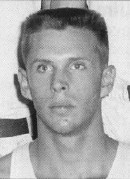 |
Years later at a Fabulous Five reunion in which Phil Rollins was present, he was asked by former UK Sports Information Director Russell Rice why he decided to go to the University of Louisville instead of Kentucky. His response was that he simply preferred the Cardinals to the Wildcats. According to a recollection of then U of L assistant coach John Dromo, the reason was deeper than a matter of preference. "He thought Kentucky took him for granted and didn't show as much interest in him as they did some other recruits... It really hurt him that Kentucky didn't recruit him as hard as it had some others, so I told him 'Why not come to Louisville and show them what they missed?' Phil Rollins had everything. He had the total package."
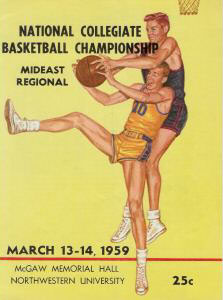 |
Little did Rupp know at the time that his words hit closer to home than he likely expected. The following year saw both teams invited to the NCAA Tournament and once again slated to face the other. Louisville received an at-large bid despite only having a 15-10 record. They actually had to face former UK player Paul McBrayer and his Eastern Kentucky squad in the first round, held in UK's Memorial Coliseum, before they had a shot at the Wildcats, who received a bye. The following game moved to the Chicago area and Northwestern's McGaw Memorial Hall.
 |
The Wildcats shot a poor 33% from the field as compared to 45% by the Cardinals. Bill Lickert was the only Wildcat to shoot well, as he led the team with 16 points. Wildcat star Johnny Cox was limited to 10 points on 3-15 shooting. Much of the credit goes to Roger Tieman who applied the defensive pressure on Cox. Don Goldstein paced the Cardinals with 19 points while Harold Andrews added 15. Said Coach Rupp to Hickman after the contest, "By gawd, you laid the wood to us tonight." Rupp reportedly admonished his team after the game saying "You know what Louisville's eating tonight? T-bone steaks. They're winners. You guys get a dollar to eat hamburgers."
Said Hickman about the turnaround of the game, "Our boys were scared going into that game...They were too cautious, afraid to let their hair down. Kentucky got us down nine or 11 points and was putting pressure on us defensively. I called timeout and said I didn't want to see any daylight between us and their guards. I wanted to put the pressure right back on them. And at halftime I decided to press all over the floor all the time."
With the victory, Louisville went on to face a tough Michigan State squad which featured star forward Johnny Green. With Adolph Rupp cheering for the Cardinals behind their bench, Hickman's squad went on to score the upset and proceeded to the Final Four for the first time in school history. The site was none other than Freedom Hall in Louisville. But despite the home court advantage, the Cardinals lost to Jerry West and the West Virginia Mountaineers in the next game.
Reminisced Hickman about what the victory over the Wildcats meant to him and the team, "Before that, I went around with my head about half up. But after we beat Kentucky, I knew I could hold my head up as a coach. I couldn't have been much happier. I knew at last that we had arrived and I didn't have to hear any more guffaw from anybody."
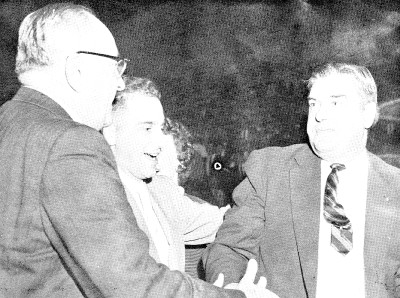 |
[Boxscore] - 1958-59 NCAA Tournament
With that game, the series would go on yet another extended hiatus. The two teams would go 24 years without meeting one another on the floor. As with the earlier stalemate, a major reason was Coach Rupp's unwillingness to schedule in-state competition during the regular season. As evidenced by the two games in the 1950's, the NCAA was interested in matching up the two schools, however this became difficult in later years as U of L became affiliated with the Missouri Valley Conference and began being placed in the Midwest Regional for NCAA play. Kentucky was generally placed in the Mideast Regional where it often met teams like Marquette and Ohio State. There were some instances where the two could have crossed paths, notably in 1961 when eventual NCAA runner-up Ohio State beat Louisville to prevent a matchup with UK and in 1964 when Ohio University won an overtime thriller in the first round to prevent a matchup with a UK team which had received a first-round bye. Incidentally, the 1964 Louisville team received an at-large invitation to the tournament based in part on lobbying by Rupp.
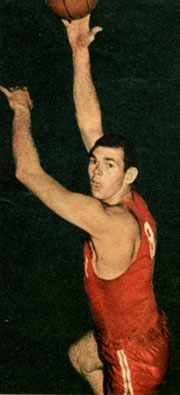 |
Another landmark recruit was that of Westley Unseld from Louisville Seneca. Unseld was a top recruit in the nation and was ranked on the first five-man team of the Parade All-American squad in 1964. Parade editor Haskell Cohen wrote in Unseld's bio for the magazine "Player scouts of the University of Kentucky, which regularly produces top teams, call rangy, rugged Unseld 'the best high school player in the country.'" Unseld was recruited hard by both Louisville and Kentucky. Just the fact that Unseld was recruited at all was a major milestone, as he was the first ever black player to not only be recruited by the University of Kentucky but by any of the historic southern white schools in the nation. (Vanderbilt was the other historic southern school to offer him a scholarship and reportedly Frank McGuire, newly hired coach at South Carolina, expressed some interest although it's not clear if the school supported him, much less was even aware of McGuire's effort.)
Kentucky was in great need of an inside post presence and Unseld would fit the bill perfectly. Whereas in the late 40's and early 50's, Kentucky had a wealth of dominating inside players, not since Bob Burrow in the mid-50's did Kentucky have a dominating post presence. Kentucky and Rupp were entering a new era of increased competition for recruits, and the now elderly Rupp was having trouble signing who he wanted, no matter their skin color. Never an avid recruiter, Rupp had grown accustomed to having recruits beat down his door to play for the University of Kentucky, not the other way around. As an example of how times had changed, when Rupp proudly presented high school star Jerry Lucas with an application for enrollment at UK, Lucas laughed in his face.
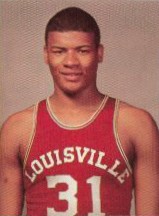 |
But the recruitment of Unseld by UK proved to be daunting. Most of it was Kentucky's fault, as in the years previous they watched idly by as standout black players like Tom Thacker and Clem Haskins played high school ball virtually under UK's nose, but were never recruited and ended up taking their talents elsewhere. When Rupp traveled to Louisville to visit Unseld at his home, Wes only stayed for a few minutes before leaving for another engagement. Rupp stayed and talked with Unseld's parents, however it was a tough sell as the elder Unseld was concerned why UK had not recruited any black players before. Lamented Rupp about the visit, "we never got anywhere at all with that situation."
Unseld received threatening letters, purportedly from Kentucky fans, suggesting he shouldn't attend UK. It was never established whether these were indeed UK fans or fans of another school masquerading as UK fans in an attempt to sway him away from the Lexington campus.
In the Spring of 1964, Unseld's heavily favored Seneca team won their second state championship in a row over Breckinridge County and an injured Butch Beard. Seneca was physically much bigger than their counterparts and many of the fans in Memorial Coliseum chose to root for the underdogs. After the game as the victors' trophies were being handed out, Unseld was rudely booed by the crowd as he accepted a trophy for being a part of the all-tournament team. Unseld had scored an amazing 105 points and collected 88 rebounds during the tournament games in Lexington. Again, it was never established whether the booing was due to boisterous Breckinridge County supporters (as Unseld surmised) or Kentucky fans trying to send a negative message to Unseld (as suggested by others). But nevertheless, it did make an impact on the young star. "It really affected him," Seneca coach Bob Mulcahy said. "In fact, I think it affected our whole team to a degree. I think it bothered him and created a situation where he realized the importance of staying home, to stay within friendly confines. His brother was at Kansas and I think up until that time, Wesley may have been leaning toward the University of Kansas."
For its part, the University of Louisville staff made a full court press to gain Unseld's services. U of L had themselves only begun to recruit black players a few years prior. In fact, the Cardinals failed to recruit Wes' brother George in 1961 despite pressure from the community to do so. George ended up signing with Kansas. When interviewed about his lack recruiting prospects at the time, George felt there wasn't much difference between the two schools. According to Lonnie Wheeler's book Blue Yonder, "People are always mad at Kentucky for being segregated so long," he [George] reflected after a long career as athletic director of the Jefferson County (Louisville) public school system, "but you've got to look at Louisville like people look at Rupp. To me, they're two peas in a pod - at least at that time."
But after that potentially fatal misstep, the Cardinals did make up lost ground by signing their first black player, Wade Houston (future University of Tennessee coach) from Tennessee, and shortly thereafter signed Eddie Whitehead and Sam Smith. The three each played in the 1963-64 season after becoming eligible for the varsity as sophomores. Smith and Whitehead would eventually be declared ineligible later in the season due to academic deficiencies (Whitehead would later return to the Cardinal team and finish out his career while Smith would transfer to Kentucky State where he would star and go on to a professional career), however the fact that Louisville had signed and played black players put them in a much better position than UK found itself in when it came time to recruit Unseld. Despite the advantage, it wasn't a given that Unseld would sign with the Cardinals. Said U of L assistant John Dromo, "He [Unseld] was supposed to go to UK the next day for a track meet, so I went to a sporting goods store and bought some books on how throw the shot put and discus (Unseld's events) so that I'd be able to talk to him about it. I was nervous. I was sure UK would grab him up there. So I went out on a limb. I said, Wesley, how about if we sign right now and get it all over with?" He said, 'Good idea.' I about fell through the floor."
The signing of Unseld signalled a new golden era for Louisville basketball. Butch Beard, who was recruited by UK and considered the offer much more seriously than Unseld ever did, eventually stood pat with a letter of intent he had earlier signed with the Cardinals. Playing in the Missouri Valley Conference, the two would finish their careers without having to play a single game in the historic deep South. The integration of basketball in the SEC would be left to Perry Wallace of Vanderbilt in 1967-68 and the others who soon followed. Despite continued attempts and near-misses throughout the 60's, Kentucky failed to sign AND play a black player until 7-footer Tom Payne, incidentally from Louisville Shawnee, took the court for the Wildcats in 1970.
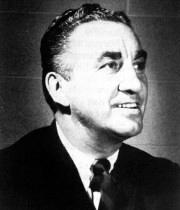 |
As mentioned, Louisville began to make waves nationally in the mid- to late 60's. In 1966-67, the Cardinals had an outstanding season as they were ranked #2 in the nation for most of the season. The following year Dromo took over the head coaching postion for Peck Hickman after 17 years as an assistant. Dromo had a good relationship with UK and Rupp. Said Dromo, "Whenever a coaching job came open in the Southeastern Conference Adolph Rupp would recommend me. He wanted to get me out of the state because we were recruiting some of the boys he wanted. I really liked Adolph and his assistant, Harry Lancaster. We had some great times together. I'll never forget seeing Mr. Rupp at a clinic one year near the end of his career. His teams had gone down some and John Wooden was stealing his thunder, winning the NCAA almost every year. Mr. Rupp said, 'John, where did I go wrong?' 'Coach,' I said, 'you made a mistake by not recruiting some black kids. You thought it was a fad that would pass, but you were wrong.' Dromo said Rupp had tears in his eye. "He just looked at me and said, 'John, if we had recruited blacks they would have burned a cross in my front yard.' It was very sad."
As the 1970's dawned, there were big changes for both UK and UL's basketball programs. For Kentucky, Adolph Rupp was forced to retire as coach after the 1971-72 season. He would end his career as the all-time winningest coach in NCAA basketball history and be replaced by a former player and UK assistant coach, Joe B. Hall. The same year Rupp was making his farewell to coaching, Denzil 'Denny' Crum was starting his first year as head coach of the Cardinals. The year prior, John Dromo's career as a head coach was cut short after a heart attack forced him to step away from the sidelines. Crum was a former player under legendary John Wooden at UCLA. The series would never be the same.
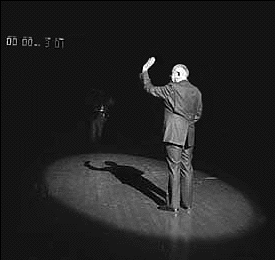 |
Continue to Part 2 - "The 'Dream Game' and Beyond."
![]()
Please note that the following reference materials were consulted for the above. 1.) Lexington Herald 2.) Lexington Leader 3.) Louisville Courier Journal 4.) New York Times 5.) Big Blue Machine by Russell Rice 6.) The Winning Tradition by Bert Nelli 7.) Above the Rim: The History of Basketball at the University of Louisville by Gary Tuell 8.) Basketball: The Dream Game in Kentucky by Dave Kindred 9.) March Madness by Mike Embry 10.) Blue Yonder by Lonnie Wheeler 11.) University of Louisville media guide 12.) University of Louisville website among others.
Return to Kentucky Rivalries, Louisville Series Results, statistics, teams, opponents, players, coaches, opposing coaches, games or search this site.
Page written by Jon Scott. Please with any corrections or additional information.
Last Updated March 22, 2003